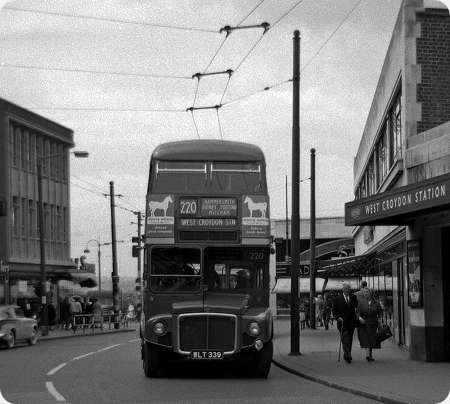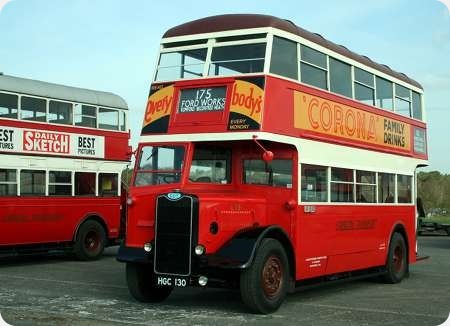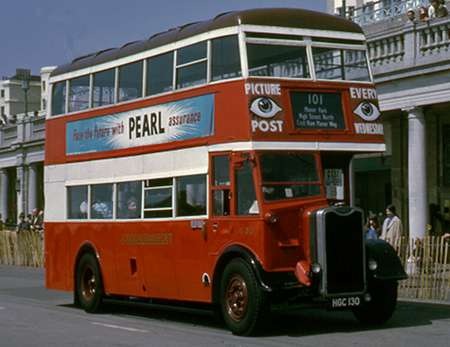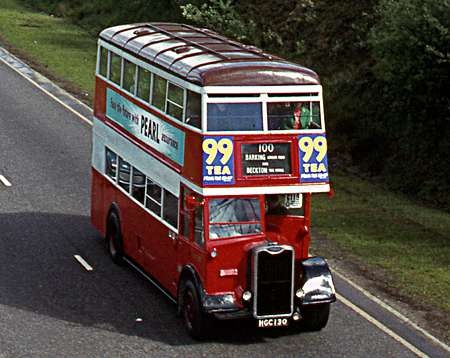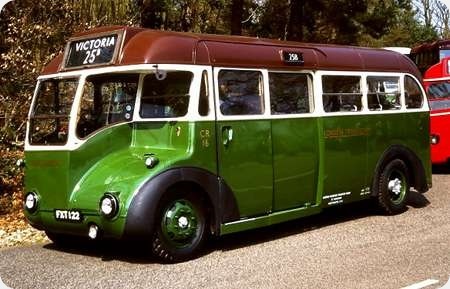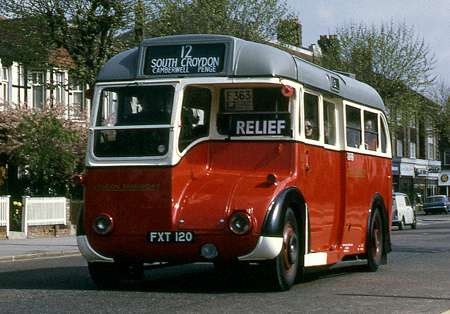London Transport – AEC Routemaster – WLT 339 – RM 339
London Transport
1960
AEC Routemaster 4/5RM5/4
Park Royal H36/28R
The 630 trolleybus route took over from the former South Metropolitan tramway that ran between West Croydon and Mitcham on 12 September 1937, and was extended northwards over ex LCC tramway routes to a destination that, on the vehicle blinds, rather indecisively declared itself to be “Nr. Willesden Junction”. It was actually about half a mile short of that point, and, many years later, the displayed destination was amended to “Harlesden”. The 630 trolleys ran speedily, quietly and reliably for 23 years, until the cheapness of diesel fuel against the price of electricity, coupled with the costs of overhead maintenance, spelt the doom of the trolleybus, not just in London, but nationwide. The 630 route fell victim to the diesel bus after operation on 19 July 1960, and brand new Routemasters on rebranded route 220 took over the following day. Here is RM 339, delivered to LT on 16 May 1960, approaching the West Croydon terminal point shortly after the introduction of the 220 route – the trolleybus overhead wires are still in situ. Today, the Croydon transport scene has changed beyond recognition, and route 220 no longer serves the town.
Photograph and Copy contributed by Roger Cox
23/10/16 – 13:37
As we know, hindsight is a exact science, and it was probably a mistake to get rid of trolleybuses. They were quick, clean and quiet, but they were restricted to where they could go by the overhead wires, they were capable of traveling short distances when disconnected, and had they been allowed to advance, its quite possible they would now be able to store energy and travel quite long distances when disconnected. They could use a pantograph instead of poles which could be dropped at the push of a button, thus allowing them to overtake each other, or go away from the wires altogether, and a single wire would probably be sufficient. Given the world we live in today, the biggest problem would probably be cable theft, or am I just being cynical?
Ronnie Hoye
23/10/16 – 13:37
I bet a lot of people wish the trolleybuses had stayed, given current concerns over pollution in towns, not to mention fluctuating fuel prices. They were quiet, comfortable and electricity could be generated in many different ways.
David Wragg
24/10/16 – 07:15
How would a trolley with pantograph and a single wire work without a return to earth. Surely a conducting strip rubbing on the road surface wouldn’t work.
John Lomas
24/10/16 – 07:16
I have seen photos of early trolleybuses, where the vehicle had a half-cab layout and even a representation of a radiator. Seeing this one under the wires, I wonder why I looked for the poles on the roof!
Pete Davies
24/10/16 – 07:18
And it’s a further irony that this section of road supports the overhead wires of the Croydon Tramlink.
The wheel has turned full circle, but I do regret the passing of London’s fabulous trolleybus system.
Petras409
24/10/16 – 07:19
The 830 route reminds me of my having a girlfriend who lived in Croydon and I used to catch the last trolleybus across to Mitcham – they could do 60mph across the common, according to a driver, with a lot of shuddering! I’d then get a 118 to Morden and walk the last two miles home. It will cause no surprise to learn that the relationship was short-lived! We did go to the Majestic Cinema at Fair Green a couple of times.
London’s trolleybuses were quite sophisticated, with regenerative braking and many had chassisless bodies, not repeated until the Routemaster. LTE had to pay a wayleave on each pole, unlike municipal operators. Also, much of the electrical infrastructure dated back to the trams and was worn out, as were the trolleybuses by the 1960’s. Electricity costs (already mentioned)and limited flexibility with route changes or new, expensive suburb extensions sealed their fate. However, to ride on them with their silence, amazing acceleration and hill-climbing ability was exhilarating!
Chris Hebbron
24/10/16 – 08:58
I think I’m right in saying that in the initial stages of design of the Routemaster there was the possibility of a trolleybus version being made.
David Chapman
24/10/16 – 10:28
John, I don’t know the ins and outs of how it would work, but I’m sure its not beyond the bounds of possibility. Remember, in 1969, the Americans sent a man to the Moon with less computer technology than there is in today’s mobile phones
Ronnie Hoye
24/10/16 – 13:22
Ah, Ronnie, you’re referring to what my son calls a camera that makes phone calls!
Pete Davies
25/10/16 – 06:41
I don’t think a pantograph would work as the big advantage of trolley poles was that if a trolleybus had broken down, all that had to be done was to lower the poles and following vehicles could then creep past it – there was that amount of leeway in the system. As a matter of interest, the very early and very short-lived Dundee system used buses with single trolleys, with the current being returned to the road surface using a trailing metal strip.
David Wragg
25/10/16 – 08:07
Never heard of that method before, David W. Why was the system shortlived; for being quirky or some other?
Chris Hebbron
25/10/16 – 14:00
The use of a single trolley pole with a return via the ground was used in the early days of trolleybuses when operators were testing them on existing tram routes. The trolleybus took the positive feed from the single overhead tram wire and used a skate running in the tram track for the negative return. I am pretty sure it was only ever used as a temporary measure under trial conditions.
Philip Halstead
25/10/16 – 14:01
This Dundee link shows picture of the first Dundee trolley which seems to have double poles/wires. www.dmoft.co.uk/2011/04
John Lomas
25/10/16 – 17:02
The system was short-lived because of the damage the trolleybus wheels inflicted on the poor road surfaces and the damage the road surfaces inflicted on the trolleybuses. As John L writes, the image he refers to does show twin trolley poles, but ‘British Trolleybus Systems’ by Messrs Joyce, King and Newman says that the trolleybuses used the existing tram overhead. The whole concept was seen as a feeder to the trams, not a replacement, giving the impression that once traffic built up or the city’s residential area expanded, the trolleybuses would be replaced by trams.
The system operated from September 1912 to May 1914, so it was Britain’s first trolleybus system, and also the first to be abandoned.
David Wragg
26/10/16 – 06:16
David, perhaps the Dundee trolleybuses were the first to operate in Scotland, as the first trolleybuses to operate in the UK were those of the Bradford and Leeds Transport Departments in 1911. Both undertakings first operated their trolleybuses on 20th June 1911 on their respective inaugural runs, but whereas Leeds then continued to operate them in service from that date, Bradford’s entered public service a few days later on June 24th. The Bradford vehicles operated on a short route from Thornbury to Dudley Hill via Laisterdyke, and connected with the tram routes on Leeds Road and Wakefield Road at either end. Leeds decided to close its system in 1928, when the trolleybuses and electrical equipment were apparently in need of replacement. In contrast however, Bradford continued to expand its network over the years and operated trolleybuses very successfully until March 1972 – the system being the last to operate in the UK.
Brendan Smith
26/10/16 – 06:17
Birmingham used the Skate to travel between depots and their overhaul works probably at night I guess.
Patrtick Armstrong
26/10/16 – 06:19
Two of those Dundee trolleybuses went to Halifax for the Corporation’s only trolley route between Pellon and Wainstalls. They were joined by a new Tilling-Stevens machine, but the route operated only from 1921 until 1926, when trolleybuses were abandoned forever by Halifax. During those five years, the trolleys ran between Pellon and Skircoat Road depot by connecting the positive trolley boom to the tram overhead and dragging a metal skid in the tram track to give the negative return to earth.
Roger Cox
27/10/16 – 08:19
If you would like an idea of what a Routemaster trolleybus might have looked like go here www.britmodeller.com/forums/ to see one modeller’s ideas and how he developed the idea and the advice he received.
Phil Blinkhorn
02/11/16 – 05:55
In Ken Blackers book he does mention that the option of electric power was considered,although given that by this times sentence had been passed on the trolleybus.
The trolleybus route 630 was intended to be worked from Thornton Heath and crews from there were provided with a staff bus whilst waiting for the wires to reach into Surrey which they unfortunately never did.
Trolleybuses should be the environmental public transport vehicle of choice, cheaper and more flexible than Trams
Patrtick Armstrong
03/11/16 – 06:20
Not quite sure, Patrick, what you mean about "the wires reaching into Surrey which, unfortunately, they never did". Croydon and Thornton Heath were in Surrey until 1973. Even Mitcham was, if I recall rightly.
Chris Hebbron
03/11/16 – 14:45
Here is another shot (rather less clear – it was taken in a heavy thunderstorm) of a Routemaster under the trolleybus wires at West Croydon. This is RM 334, taken into LT stock on 12 May 1960. If there ever was a project to make a trolleybus version of the Routemaster, it must have been abandoned early in the development programme, since the decision to abandon London’s trolleys was absolutely cast in stone by 1954, the year in which RM 1 appeared. On the subject of trolleybuses running in Surrey, parts of Croydon may well have been in the postal district of Surrey (some fell within the London SW postal area), but it was a self governing County Borough from 1889 until 1965 when it was incorporated into the GLC. Thus, trolleybuses never did run in the county of Surrey proper.
Roger Cox
04/11/16 – 06:16
With apologies to Chris H, he is right. Mitcham was a municipal borough in Surrey from 1915 to 1965, so yes, trolleybuses on route 630 did just enter the very northern tip of that county.
Roger Cox
06/11/16 – 09:52
That’s a lovely shot of RM334, Roger, ploughing through rain. I like evocative photos like this, as my recently-posted one of Morden Tube Station forecourt, in driving snow, testifies.
Apologies graciously accepted about the 630 route going through Surrey! I had kept some of my powder dry to mention the Fulwell Depot trolley routes 601-605, some of them working their way through Kingston to Tolworth and Wimbledon. Kingston-upon-Thames was only a borough, albeit a Royal one (I’m on one knee as I type this)! I’m old enough to recall travelling from Raynes Park to Kingston/Hampton Court) on the ‘Diddlers’ that frequented the 604/605. Poor things, sound chassis but frail bodies, even when extensively rebuilt, they creaked their way around and were replaced none too soon. I’d hazard a guess that they were the most worn-out vehicles London Transport ran at that time, lasting from 1931 to 1948. But I digress (again)!
Chris Hebbron
Quick links to the - Comments Page - Contact Page - Home Page
